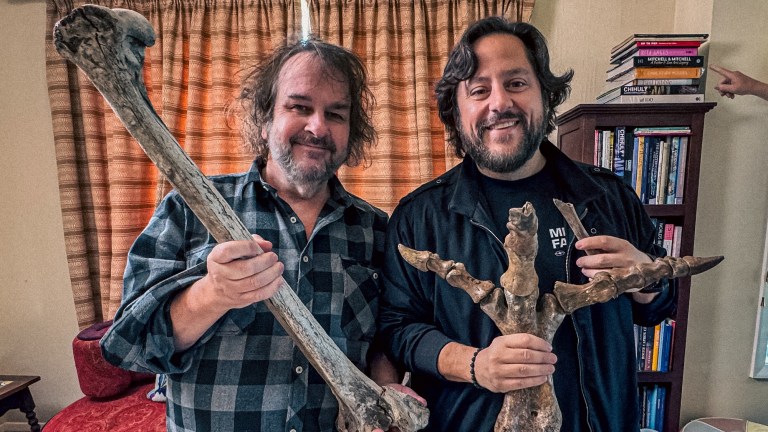Peter Jackson Is Helping Bring Back a Massive Prehistoric Bird 600 Years After Extinction
The famed Lord of the Rings director has donated his money and his bones to make a legend come to life with Colossal Biosciences.

Whenever you see headlines about various extinct animals coming back to life, your first thought might be, “But what about prehistoric animals?” Recently the genetics and biosciences company Colossal revealed that it had figured out how to resurrect a version of the dire wolf, leading to all sorts of excitement that we’re living in a kind of real-world Game of Thrones situation. But in terms of sheer size, the dire wolf isn’t actually a huge, ancient animal. On the other hand, the giant moa, also known as the Dinornis, was massive. In fact, the largest fossil ever discovered of such a creature was 12 feet tall.
And soon, these giant creatures—which have been extinct for roughly 600 years—will once again be walking among the land of the living. Through the so-called de-extinction efforts of Colossal, the giant moa is anticipated to live again. And none of it would be possible without Peter Jackson. Yes, that Peter Jackson, the man who brought The Lord of the Rings to the big screen and gave us the best Beatles documentary of all time. Without Jackson’s donations and his personal collection of moa bones, Colossal would not have been able to make this miracle of modern science happen.
Why the Giant Moa is Coming Back
“Peter really opened the gates for it to actually be possible,” Colossal CEO Ben Lamm tells Den of Geek. “He was kind of disappointed that the moa wasn’t already on the list and highly encouraged me. He’s been very influential in his suggestions.”
The list that Lamm is talking about is a wishlist of species that Colossal wants to bring back. And, in order to invest in the project, Jackson made it clear he wanted the giant moa to be a priority.
“Fran [Walsh] and I invested in Colossal on the basis that the moa gets added to the list, that was a condition of our investment,” Jackson says while mentioning his wife and writing partner. “As kids in New Zealand, we grew up with stories of the moa. We were very proud of having the biggest bird. And the more you learn about it, you realize that the Māori were so dependent on this bird.”
The Key to Ancient Māori History
For the de-extinction of the giant moa, Colossal has partnered with the Ngāi Tahu Research Center, which Lamm says is essentially the lead on the project. These archaeological experts, who hail primarily from New Zealand’s southern region, deal directly with the Māori legacy. And as Jackson makes clear, the giant moa isn’t just some cool prehistoric creature; it’s an essential aspect of ancient Māori life.
“As a de-extinction fan, obviously I knew about the moa,” Lamm says. “But then when I started to learn about some of the cultural heritage and just the backstory on the moa, I just got more and more excited. It truly has a special place in the New Zealand ecosystem and a unique place with the Māori’s unique history.”
Jackson also points out that ancient Māori people in New Zealand didn’t just treat the moa as a mythical creature but rather used it as a resource in all aspects of their lives.
“They immediately had the source of protein that these big animals could provide,” Jackson explains. “It was an incredible resource for them. It was actually probably one of the first examples in the world of over-resourcing, which is why they ultimately became extinct. We’re focused on the giant moa because the Ngāi Tahu tribe in most of the South Island had this bird centered as a major part of their culture.”

How Not to Clone Extinct Animals
Because dinosaurs lived so long ago, the idea of cloning them and bringing them back to life, a la Jurassic Park, is pretty much impossible. In fact, the process that has begun to bring the giant moa back to life is much more difficult than you might think.
“Amber is not a good DNA storage. It’s highly porous,” Lamm explains, referencing the famous idea that mosquitoes trapped in amber might hold the secret of dinosaur DNA. “Sometimes people put mammoths in their brain with the actual dinosaurs, but there’s about 65 million years between that, right? We can go back about as far as two million years, but at some point, a lot of those bones turned to fossils and so they turned to rock. So there’s no current way to extract DNA from rock because all the material is lost at that point.”
In order to bring back the giant moa, Lamm and his team have been looking at various bone samples, many of which were donated by Peter Jackson himself. Yes, Jackson owned some moa bones, and some of those bones have been part of the process of bringing the extinct beast back to life. But finding bones with still-intact giant moa DNA is tricky.
“Just to give you a sense of it, we collected about 400 moa bones, and we looked at them one by one,” Jackson explains. “And if a bone is porous and it’s lightweight, the DNA is going to be really bad in it because it means that it’s all been leached out, washed out. So of the 400 bones, only 25 of them were deemed to have potential DNA. And of those 25, only two produced viable DNA. That just shows you what the mathematical issue is here.”
Still, Colossal has its eye on the prize. Jackson is enthusiastic and says he’s long looked forward to this kind of technological breakthrough after being a child reared on ‘60s science fiction.
“I was looking forward to the day that we’d be flying around on personal jetpacks and flying cars and bringing back the dinosaurs,” Jackson says. And now, in a sense, it may actually be happening.
“I think it is kind of one of the closest things to a dinosaur that existed,” Lamm says. “And so if you’re a fan of Jurassic Park, if you’re a fan of this kind of thing, then I think it’s pretty awesome.”
